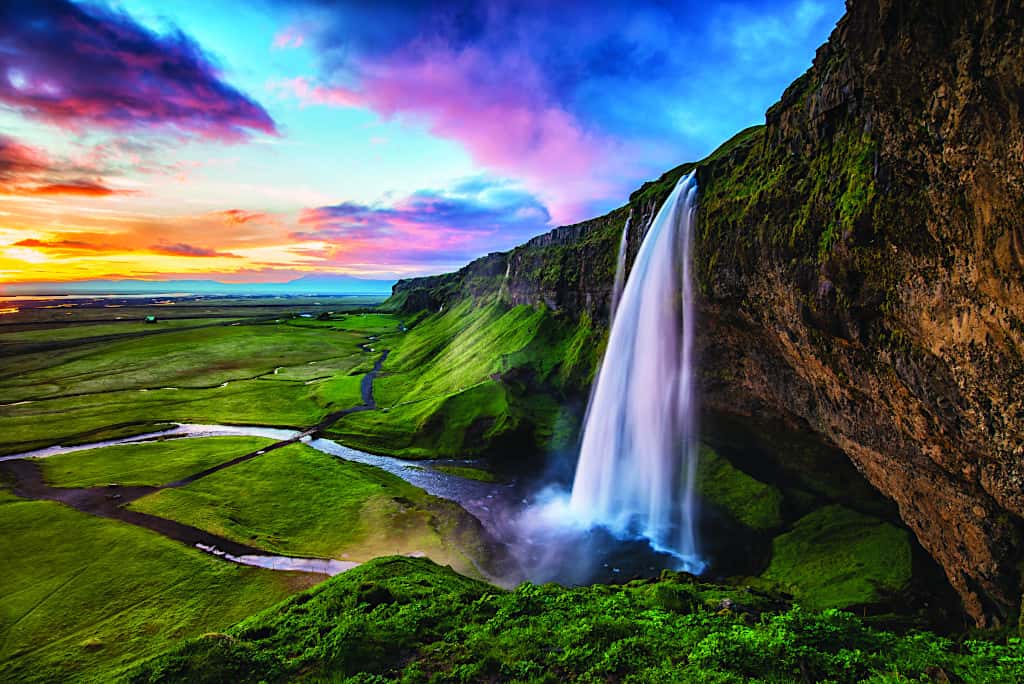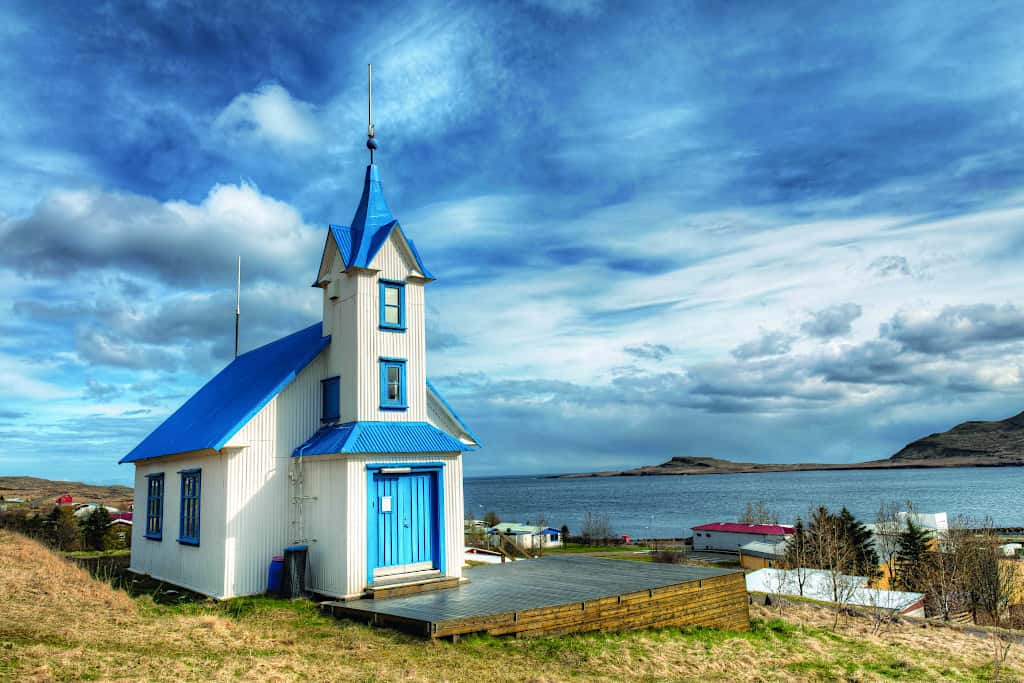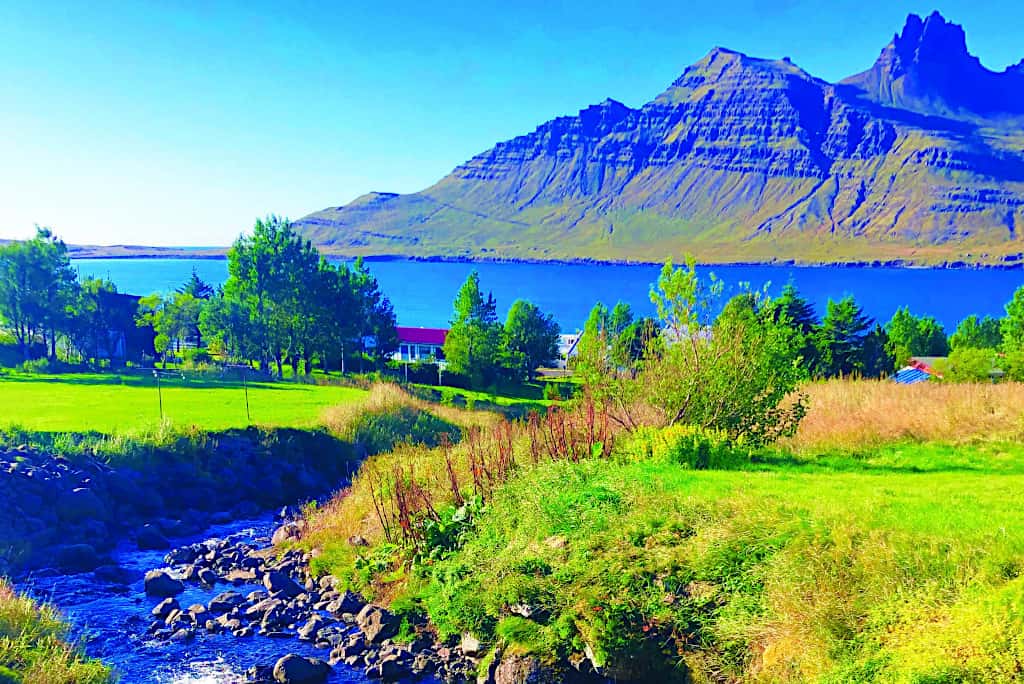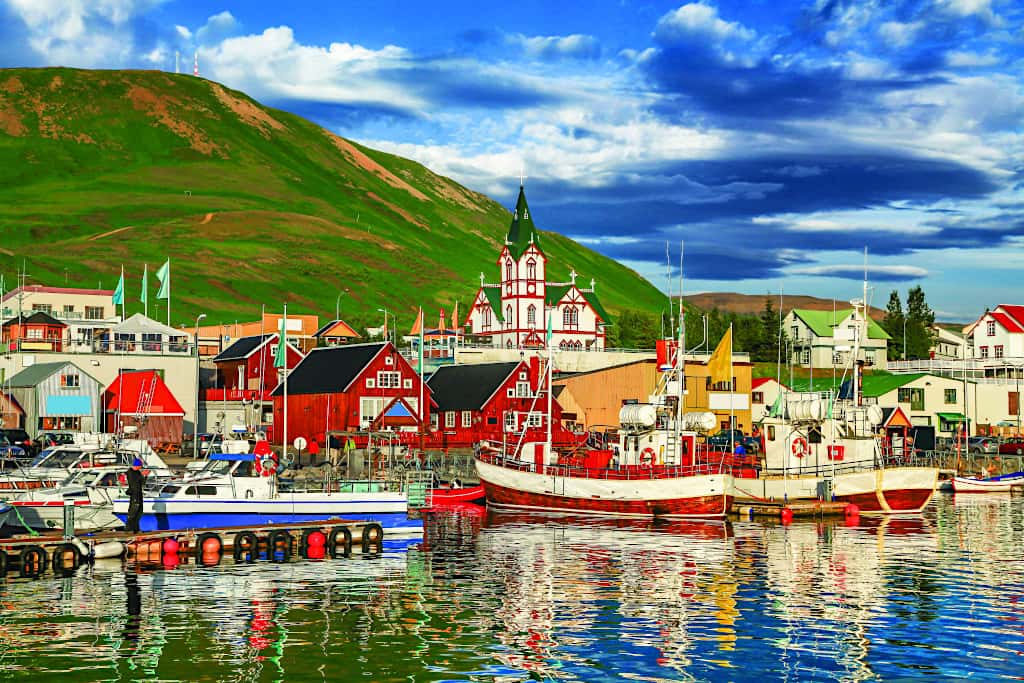
You may be more essential than you’ve ever imagined.
You are also inessential, in ways that can fill you with wonder and hope.
Those are among the many lessons I learned on an unusual trip to Iceland in 2020. Other highlights from my happenstance syllabus: You should just say no to jelly on pizza; You should consider building an elf house in your yard; Squirrels have corkscrew-shaped penises. These personal epiphanies, cultural insights, and trivial oddities that make travel such a joy have been sorely missed since my trip to Iceland. I can’t wait to continue roaming the globe in pursuit of experience, knowledge. and surprise.
I made plans to be in Iceland well before the pandemic kicked in. For the month of September, I’d join a small group of international creatives at an arts retreat in the remote eastern fjord town of Stoovarfjorour, but as the world went into a deep lockdown, I resigned myself to an inevitable postponement. Sure enough, in late spring, Iceland, which even at this writing has experienced only 29 covid deaths, shut its borders to tourists from the U.S., where the number of deaths has gone on to far exceed Iceland’s entire national population.
Before cancelling my flights, I decided to check in with the Icelandic government. To my astonishment, I was informed that I was no mere tourist. As a writer who’d been accepted into a program with recognized cultural and educational value, I was still welcome. Provided I tested negative for COVID-19 at the airport on arrival, quarantined for five days, then tested again to get the all clear, I qualified for an exemption from the travel ban. This was a head spinner. A government policy that effectively deemed artists’ work essential? How strangely humane. This was a sort of institutional respect I’d never felt before. In the midst of a violent, contagious pre-election American summer, Iceland’s allure increased exponentially.
What is now my all-time favorite travel souvenir was in my hands before I left home: An official letter from the Icelandic Ministry for Foreign Affairs. My permission slip.
Stoovarfjorour is a tiny place of enormous beauty. With a population that hovers just above 200, it sits on a gentle slope, corrugated by narrow, trickling streams. The modest houses are oriented toward the south, where an icy finger of the Atlantic beckons fishermen to come try their luck. Across the water, there’s a sudden jut of jagged mountains, like the back of a sleeping dragon. In the sunshine, they’re green with futon-thick moss that grows on every available inch of soil. When rain rolls in, they’re a foreboding gray, peaks cut short by a shroud of fog. On lucky clear nights, the mountains’ rough-hewn drama receded, upstaged by mysterious green scrims of aurora borealis afloat in a skyful of nonpareil stars. During those nights,and in many moments yet to come alongside waterfalls, in volcanic fields and on the open road, I reveled in my own tininess; in that sense of spiritual relief and refreshment that comes when considering oneself within nature’s grand scale.
Stoovarfjorour is one of many small villages in Austurland (Eastern Iceland) that have been economically devastated by the consolidation of their country’s seafood industry over the past two decades.
Massive firms have bought up, then shut down, smaller companies throughout the fjords, centralizing their freezing and processing at a few strategically located mega-plants. In towns long reliant on independent local plants as their economic engines, the result has been an exodus of young people in search of employment and abandoned wharfside factories falling into disrepair.

In Stoovarfjorour, though, they’re trying to take a different path. Six years after the local seafood plant shuttered in 2005, a volunteer-fueled non-profit organization came together to rehabilitate the dilapidated building and establish the Fish Factory Creative Centre. Today, the 30,000 square foot, mural-festooned structure is home to art and writing studios, a small performance space, an analog recording studio, and dedicated, well-equipped workshops for ceramacists and wood workers.
Under the guiding hands of multi-media artist Una Sigaroardottir and her British-born husband, music producer Vinny Wood, the Fish Factory not only hosts artists’ residencies, but produces musical performances, art exhibits, workshops, and arts education programs for the public of Austurland (Eastern Iceland). It’s not uncommon for citizens of this sparsely populated region to drive 100 miles for a concert at the Fish Factory.
If you’re ever in the neighborhood, knock on the door and ask for a look around. If you’re a writer, painter, musician or some other kind of artist, apply to stay a while. It’s an essential institution.
Perhaps you’re wondering what it’s like to be a single gay man in these beautiful boondocks. I’ll say this: I’m glad I’m not a single gay man. Sure, I was 4,000 miles from my San Francisco partner, but I was just away for 5 weeks and we’ve been together for over 10 years. Call it an absence-makes-the-heart-grow-fonder scenario.
If you actually lived in Stoovarfjorour? Yikes. There’s not a bar, let alone a gay one. Through the orange glow of that global nightspot known as Grindr you can still find guys of all ages, but in Iceland the entire country is considered “nearby” and the 400-odd miles to Reykjavik doesn’t exactly make for easy romance, let alone booty calls. Almost 30% of the national population lives in greater Reykjavik, including an even higher percentage of Iceland’s queer population, who appreciate the urbane attitude, arts and hospitality industries, and community groups like Samotkin 78, the major national queer rights advocacy organization.
Yet despite a lack of concentrated queer community throughout most of this rural country, there’s an abundance of inclusion and acceptance. Same-sex marriage, anti-discrimination, adoption and surrogacy rights are all robust. Perhaps even more notably, same-sex couples sharing hotel rooms, dancing in mixed clubs, and holding hands or otherwise displaying affection in public are considered everyday norms. So while Iceland may not be a typical gay hot spot, it offers a notably warm welcome.
Bonus lesson: According to the Icelandic gay men I chatted with online and at Kiki, Reykjavik’s sole gay bar, foreign tourists are embraced; the local scene is small, so visitors’ combination of fresh faces and no strings has undeniable appeal.
For me, spending four weeks in a small town with stunning natural surroundings and only a single commercial establishment, a combination general store/café/diner, was a creative boon: Marathon writing sessions, long hikes, deep thoughts, and none of home life’s daily distractions. Truth be told, there was also plenty of time to hang out at Brekkan, that ramshackle shop/restaurant, where you can find everything from mittens to canned peaches, romance novels, cheeseburgers, omelets, and duct tape.

Rosemary, the cheerful proprietress, accustomed to Fish Factory foreigners lingering around her premises, was quick to share some of Iceland’s culinary quirks. Most welcome was her solid, though perhaps life-threatening, advice on getting the most short-term enjoyment from Iceland’s traditional rugbrauo, or rye bread. Bearing little resemblance to what’s found in American delis, Rosemary’s homebaked exemplar (Thursdays only) sits about halfway between moist pumpernickel and spice cake, a bit sweet with a remarkably fudgy texture. Selling me a warm loaf, she dispensed this guidance: “However thick you slice the bread, put butter the same thickness on top.”
On Friday evenings, Rosemary and a small crew crank out dozens of pizzas as the shop’s communal tables fill and a parade of well-worn pickup trucks swings by for grab to-go orders. If you’re eating in, pies come to the table accompanied by parmesan, red pepper flakes and, as forewarned, grape or berry jelly.
A quartet of Icelandic acrobats were working at the Fish Factory at the same time I was, and over a shared pizza dinner, I raised an eyebrow and a cringing “What’s up with that?”
“Um,” replied aerialist/tumbler Joachim with a shrug, “It tastes good. The fruit and the cheese is a nice combination.”
Furthering this line of reasoning, topping options at pizza joints throughout Iceland typically extend beyond the likes of sausage, pepperoni, and mushrooms to include sliced bananas. Uninterested in experiencing intestinal versions of the contortions routinely performed by Joachim and company, I passed.
When I asked what other Icelandic specialties I should try, the acrobats informed me that the fermented shark meat, roasted sheep heads, and pastrami-smoked puffins ballyhooed in guidebooks are historic and touristic, primarily consumed by vanishing generations of older Icelanders, attendees of folk festivals, and self-anointed foreign “adventurers” intent on feeding social media as much as themselves.
From WWII through 2006, the United States maintained a large naval operation just outside the Icelandic capital of Reykjavik and, as my new friends explained, elements of American pop culture that appealed to base personnel (from food to entertainment) had a lasting impact on an isolated rural country that had not yet become a nexus of international tourism.
Pizza and burgers are ubiquitous nationwide. Reykjavik has a punk rock museum, and a restaurant called the Chuck Norris Grill. In the Eastern City of Egilsstadir, there’s a Happy Days-style diner with red vinyl booths, a jukebox full of American ‘50s singles, and several giant statues of Betty Boop (but such is the blur of non-native nostalgia). All Icelandic children learn English beginning in grade school and virtually everyone under 60 speaks it fluently.
Still, beneath the veneer of familiarity that has made tourists from the U.S. feel at ease visiting Iceland (440,000 Americans came in 2019, almost 25% of all foreign visitors) is an alluring strangeness. The mundane and the fantastic are seamlessly interwoven.
The elf houses, for instance. I first noticed them in Stoovarfjorur; miniature homes with peaked roofs, little doors and windows, sometimes even wee flagstone paths and picket fences. Too big to be birdhouses and too small for most dogs, they are built by Icelanders for ambiguous purposes. Ask, and you’ll be told about the hidden people, or huldufolk, tiny creatures with origins in pre-Christian Norse folklore, generally kind but potentially ill-tempered imps, highly protective of the natural world.
Some Icelanders will insist that the houses have been erected by the elves themselves; others will acknowledge building the houses, but claim they’ve done it to appease the little folk and keep their mischief at bay. Still others describe the houses as a sly form of eco-protest: “Don’t mess with Mother Nature” articulated via architecture. There are even cynics who suggest that these dinky domiciles are a sort of Disneyfication: cheesy tourist bait built on the bones of sacred mythology.
This last theory feels unconvincing to me. While I certainly spotted some mini-manors alongside commercial hot springs and in other heavily touristed areas, I also came upon them in small town backyards, along desolate stretches of highway and miles into wilderness hikes. No doubt they’re manmade, but why?
I asked Una, the Fish Factory founder, whether Icelanders really believed in elves. “I won’t say we believe in them,” she told me with a raised eyebrow and a scrunch of her septum-pierced nose, “but I can’t say we don’t.” In conversations over coffee in the Factory’s lounge, she professed a similarly cheerful resistance to certainty about religion, gender roles, and other beliefs to which some hold tightly. And she is hardly alone in her feelings. On this isolated island where sun and rain and light and dark interweave in unpredictable patterns, where steam erupts toward the sky, and clouds dip low to the ground, mystery and ambiguity are embraced.
Nowhere is Iceland’s other-worldliness more apparent than three hours northwest of Stoovarfjorour in the Lake Myvatn region, with more than 2,000 square miles of non-stop astonishment. Driving through this volcanic landscape, I moved from dry brown desert to thunderous waterfalls to placid lakes; from boiling mudpots to lush sheep meadows to the surreal fields of gnarled lava rock formations known as Dimmuborgir, alleged by some to be gates to the underworld and known by many as Mance Raydar’s camp in HBO’s Game of Thrones. The density of spectacle here is mind-boggling: imagine being able to visit Yellowstone, Bryce Canyon, and Niagara Falls in just a few hours’ drive.
In fact, Niagara contains far less of Iceland’s bounty of close to 10,000 cataracts, beginning with the fact that not one of them has a Hard Rock Café or Ripley’s Believe It Or Not Museum in spitting distance. The government has done an extraordinary job of making the country’s natural wonders accessible to visitors while treating its wilderness landscapes with reverence and respect. Hiking paths are remarkably well maintained, roadways are unblemished by billboards or parking areas, and concessions are unobtrusively designed and located.
In the Myvatn region, one can explore Dettifoss, Europe’s most powerful waterfall, with endlessly roaring mists and rocks that tremble beneath your feet; Selfoss, just a short hike upstream with dozens of cascades of glacial meltwater along a rock canyon wall; and Godafoss, the crescent “waterfall of the Gods” that is over 1,000 feet wide.
Just 40-minutes north of Godafoss on a peninsula 36 miles below the Arctic Circle is Husavik, population 2,300. It’s the closest thing to a tourist town in north Iceland, especially since being good-naturedly mocked in last year’s Will Ferrell comedy, Eurovision Song Contest. A charming fishing village, and Iceland’s whale watching capital, Husavik makes an ideal overnight stop on a two-day driving loop that includes the waterfalls, bathing spots, Myvatn, and the Asbyrgi Canyon, an eye-popping horseshoe-shaped valley, bordered on three sides by a rock wall more than seven miles long from end to end.

In recent years, this route has been promoted by regional tourist bureaus as the Diamond Circle, a playful attempt to one-up the famous Golden Circle of sights close to Reykjavik. These campaigns have not had much traction in the U.S., but let me be the first to tell you, the oneupsmanship is well warranted.
Iceland is most heavily touristed between the months of June and August, but even in peak periods, far more travelers concentrate their time in the country’s southwest than its northeast. That’s because Keflavik International Airport, just outside of Reykjavik, is the only global gateway to the country. From the U.S. east coast, it’s just a five to six hour flight; the most faraway-feeling place you can go in such a short amount of time.
That easy access is part of why, in 2019, the average number of nights spent by American tourists in Iceland was only 5.6. Trips of 10 days or more spent circumnavigating the island’s famous Ring Road were far surpassed by long-weekend jaunts to party under the midnight sun and tick the bucket list.
On such short stays, it’s easy to understand why visitors would stick close to the capital. There are plenty of organized bus tours and easy self-drive day trips to keep folks clinging close to Reykjavik’s bustling bar scene and the heavily promoted Golden Circle attractions. In just three intense days based in a single downtown hotel room, its possible (and, in fact, worthwhile) to take in the punctual eruptions of the famous Geysir, the arrowhead cascades of the Gullfoss waterfall, the crust-busting clash of the Nor th American and Eurasian tectonic plates in Thingvellir National Park, the black sand beaches and basalt columns rising from the Atlantic in Vik, and, if you push yourself, magical mossy Fjaðrárgljúfur canyon.
This will even leave you with time to amble about central Reykjavik on foot. Make sure to visit the waterfront concert hall, Harpa, a shimmering marvel of modern architecture, and enjoy the lively café scene, highlighted by the gay-owned bi-level Babalú, on a crafty boutique-filled block with a fine view of the city’s most famous landmark, the Hallgrimskirkja, a Lutheran church with a spire embraced by sweeping stone wings that resemble a giant pipe organ.
On your way to catch your flight home, by all means stop for a soothing soak in the Smurf-colored shallows of the world-famous Blue Lagoon , Iceland’s most popular tourist site. Despite being a man-made attraction in this natural wonderland, it’s conveniently located near the airport.
With all that said, let me share the most beneficial lesson for time pressed American travelers that I learned in Iceland: If you can give yourself even five days on the ground, you can cover all of the above (i.e. everything your basic friends have boasted about) and the far less trafficked, far more fantastical northeastern route that was not just the highlight of my trip last summer, but a highlight of nearly four decades of travel.
Immediately upon arriving to Keflavik from the U.S., take a domestic flight to Egilisstadir (Under $225 roundtrip), where you can rent a car at the airport, take the mind-blowing Diamond Circle road trip, and be back to Reykjavik in as little as 48 hours.
When you return to the capital, if you’d like to learn more about that corkscrew squirrel willy I mentioned in the very first paragraph of this essay, make your way to the carefully curated not to be missed collection of over 200 preserved penises on display at the Icelandic Phallological Museum, a veritable spew lagoon. Every mammal found on the island is represented, along with an ample sampling from the surrounding seas (walrus wangs, seal scepters, and 16 different whale weiners), some global exotica (Gotta have an elephant!), an impressive human specimen (the subject of a documentary film, The Final Member) and, in a classic Icelandic move, alleged elf penises (a wall placard explains that they’re invisible).
You never know exactly what you’ll learn through traveling, but from the silly to the sublime, the lessons are out there. Its high time we get back out there as well.
Iceland Resources
GENERAL INFORMATION/TOURS
Guide to Iceland. Excellent trip-planning resource with accommodation and tour booking in addition to in depth background info, including a section on LGBTQ travel. www.guidetoiceland.is
Iceland Naturally. Another reference hub with excellent info on culture and arts happenings nationwide. www.icelandnaturally.com
Pink Iceland. Hverfisgata 39, Reykjavik. Tel: 354-562-1919. Gay-owned and focused travel agency that can help arrange and guide tours for queer travelers nationwide. Visitors are welcome to stop by for friendly advice at the Reykjavik office. www.pinkiceland.is
REYKJAVIK
ACCOMMODATIONS
Sif Apartments. Briertartun 9. From $150.00. Tel: 354-550-8900. Beautifully furnished, ultramodern apartments in walking distance of major shopping streets and cultural attractions. www.sifapartments.is
Hotel Odinsve. Thorsgata 1. From $150.00. Tel: 354-511-6200. Chic, minimalist boutique hotel with highly regarded Scandinavian restaurant, Snaps. Excellent central location. www.hotelodinsve.is
Refurrin Reykjavik Guesthouse. Aegisgata 26. From $100. Tel: 354-840-7275. Clean, budget priced guesthouse with shared bathrooms. Charming central location in leafy residential neighborhood. www.refurinn.is
EAT & DRINK
Matur og Drykkur. Grandagarour 2. Tel: 354-571- 8877. This rustic but upscale Michelin pick is perhaps your best choice for sophisticated, authentic Icelandic cooking without touristy gimmicks. Extraordinary.https://www.maturogdrykkur.is/
Café Babalu. Skólavörðustígur 22. Tel: 354- 555-8845. Two-story gay-owned café and restaurant with an outdoor deck and wholesome simple fare, including an excellent tomato soup.
www.facebook.com/Cafe-Babalú-137866499616262/
Grandi Matholl. Grandagarour 16. and Hlemmur Matholl. Laugavegur 107. Lively affordable food halls with stalls, bakeries and sit-down restaurants featuring a range of well-made cuisine and a vibrant social scene. www.grandimatholl.is, www.hlemmurmattholl.is
Kiki Queer Bar. Laugavegar 22. No phone. Drag shows, dancing, and community events. Fun and welcoming. www.kiki.is
STOOVARFJOROUR AND NORTHERN ICELAND
ACCOMMODATIONS
Fosshotel Husavik. Ketilsbraut 22, Husavik. Tel: 354-464-1220. From $75. Contemporary hotel within 5 minutes walk from the whale watching harbor. Ideal midpoint for a two-day driving loop beginning and ending in Egilisstadir. www.islandshotel.is
Kirkubaer Guesthouse. Fjaroarbraut 37a. From $60. Tel: 354-892-3319. A one-of-a-kind converted converted church with 4 double rooms and vista views of the fjord. Full buyout available for groups. Boat and kayak rentals. www.kirkjubaerguesthouse.com
Saxa Guesthouse. Fjaroarbraut 41. From $79. Tel: 354-511-3055. Clean, simple hotel with good breakfast available. www.booking.com
Vogafjos Farm Resort. 660 Myvatnssveit, Myvatn. Tel: 354-464-3800. If you can spare an extra day in the Diamond Circle, this unique hostelry features a breakfast room with sweeping sheepmeadow views and plate glass windows that look directly into a milking barn, so you can see where some of your meal is made! Fantastic location for hiking the lake and the Dimmuborgir rock formations. www.vogafjosfarmresort.is
EAT (AND SHOP)
Brekkan. Fjaroarbraut 44. Tel: 354-475-8939. The only game in town. Friday is pizza night! www.facebook.com/brekkan.stf
VISIT
The Fish Factory Creative Centre. Bankastraeti 1. Tel: 354-537-0711. Drop by to meet resident artists from around the world. Apply for a residency of your own. https://inhere.is
TRANSPORTATION
Egilisstadir Airport. Miovangur 2. Tel: 354-424- 4000. Gateway to the Eastern Fjords and the Diamond Circle, one hour’s flight from Reykjavik. Rent and return cars from major rental brands here. www.isavia.is/en/egilsstadir-airport
